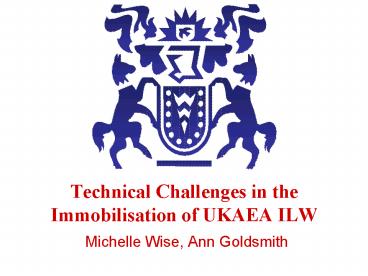Technical Challenges in the Immobilisation of UKAEA ILW
1 / 35
Title:
Technical Challenges in the Immobilisation of UKAEA ILW
Description:
Technical Challenges in the Immobilisation of UKAEA ILW ... HALS Tank _at_U. Example Challenge- PFR Raffinate. PFR fuel reprocessed at Dounreay. 1980-1996 ... –
Number of Views:100
Avg rating:3.0/5.0
Title: Technical Challenges in the Immobilisation of UKAEA ILW
1
Technical Challenges in the Immobilisation of
UKAEA ILW
- Michelle Wise, Ann Goldsmith
2
Outline
- UKAEA Policy on Waste Management
- Overview of UKAEA Wastes
- Example Technical Challenge
3
UKAEA Policy
- Compliance with regulator requirements and
expectations - Aim for passive safety
- Prioritise on basis of hazard, aim for
progressive reduction - Demonstrate BPEO/BPM as required
- Conditioned wastes consistent with future long
term management
4
UKAEA Sites
5
Overview of Wastes- Solids
- Stored, Untreated Wastes
- Often incomplete records
- Inappropriate storage/ disposal arrangements
- silo Dounreay shaft
- mild steel containers
- designed without sampling in mind
- Sea disposal packages
- Wastes from decommissioning old facilities
- Incomplete records
- Time drivers
- need to avoid creating new problems
- Fuels
6
Harwell RHILW
- Historical waste in Tube Stores
- concerns over condition (mild steel containers)
- uncertainties over contents
- Accessibility
- retrieval machine, further requirements
- Waste Requiring Additional Treatment (WRATs)
- records may be misleading
- Assay
7
B462 Head End Cells
8
Dounreay Silo and Shaft
- Retrieval even more difficult
- Throughput orders of magnitude higher
- Little or no link to records
- if contained, no numbers!
- Parallel sludge and solids treatment
- little sludge characterisation
- Criticality and analysis issues
- Have to think in completely different way
9
(No Transcript)
10
Overview of Wastes- Liquids
- Minor process residues
- organic solvents, may be in solid waste stream
- Floc from Effluent Treatment
- Harwell Sludges borderline LLW
- Specific Waste Streams
- Harwell Liquors
- Winfrith Sludges
- Dounreay Raffinates
- New waste streams
- e.g. from NaK/ sodium treatment
11
Harwell Sludges
- From floc treatment of low-medium liquors
- Accumulated over decades- settled
- Main problem is mobilisation of solid mass
- are samples representative
- New plant designed and built
- Incorporates active cementation lab
12
(No Transcript)
13
SGHWR Sludge Issues
- Variety of Sources
- ion exchange material (Powdex)
- filter aid
- decontamination operations
- Radionuclide Inventory
- analysis to date not comprehensive
- difficult to predict
- questionable how representative
- Chemical Inventory
- not comprehensive, e.g. wrt complexants
14
(No Transcript)
15
Resolution
- Trials to develop envelope using real samples
- takes into account ageing
- formulation based upon solids range
- Conservative scoping inventory estimates
- Scoping encapsulation trials to examine effect of
complexants - Comprehensive sampling and fingerprinting
protocol for retrieved wastes - Test blocks from each batch
16
Dounreay Process Liquors
- High Risk- Drive to Process
- Removal and Treatment of Liquors
- PFR Raffinate (203m3)
- DFR Raffinate (219m3)
- MTR Raffinate (807m3)
- currently being encapsulated in DCP
- ADU Floc (116m3)
- Heel in Tanks
- getting it out
- content
- chemical and radiological
17
(No Transcript)
18
HALS Tank
19
Example Challenge- PFR Raffinate
- PFR fuel reprocessed at Dounreay
- 1980-1996
- Fuel in basket dissolved in conc. nitric
- basket introduces Zn and Cu
- Solvent extraction used to separate U/Pu
- PFR raffinate is the aqueous effluent from the
first stage washing - numerous batches, with different sources
- batches/ contents concentrated by evaporation
20
Composition of Raffinate
- Uncertainty
- only old samples- further additions/ removals
- analysis not comprehensive- e.g. no H-3, acidity
or Tank 15- potentially inconsistent - re-analysed/ re-assessed- found chloride
- re-sampling planned
- Previously considered as HLW on basis that future
campaigns would process higher burn-up fuel and
be concentrated further- this didn't happen
21
Options for Immobilisation
- Vitrification
- standard for HLW
- until recently reference strategy
- difficult to transport, or require gt40M plant!
- Cementation
- feasible because heat output is relatively low
- tanks incorporate cooling, but not required
- product would be within Nirex limits, i.e. can be
considered as ILW, not HLW - DCP unsuitable (inflexible), DCP2 required
22
Wasteform Development Lab at Harwell
23
Small-scale Scoping Trials
- Preparation of simulant cement mixes at 150
ml scale - use Kenwood Chef and polypots
- Determination of time to initial set
- Measurement of mix viscosity
- Measurement of bleed water
- Observation of change in physical appearance
24
Variables Examined
- Options for neutralising acid
- NaOH solution
- Ca(OH)2 powder
- mix NaOH and Ca(OH)2
- Cementation trials with
- (over) neutralised nitric acid solution
- neutralised worst-case simulant liquor
- effects of key cations independently
- 11 PFAOPC and 11 BFSOPC
25
Results
- PFA performed better than BFS
- 75 Ca(OH)2 (where precipitation started),25
NaOH sequence best- no excess - Effect of cations varied with cement and with
neutralising agent - in one case, Zn delayed set gt14 days
- Defined envelope for confirmatory tests
26
Formulation Working Envelope
1.221
C "fluid mix
recommended formulation
PFA/OPC Ratio
11
A
B "thick mix"
0.821
0.40
0.42
0.38
W/S Ratio
27
Product Evaluation Tests
- Larger scale mixes of about 1 litre
- Profile of heat release
- Mix viscosity/ rheology
- Matrix density
- Compressive strength
- Dimensional stability
- measure expansion/ contraction
- Confirm previous measurements
- Bleed water, Initial set time
28
Calorimeter
29
Viscometer
Paddle and Pot
Automatically generates rheogram
30
Compression Testing Machine
31
In-situ Microstrain Measurement
32
Rate of heat release
33
Cumulative heat release
34
Microstrain measurements
35
Conclusions
- UKAEA has a range of historic wastes, and wastes
from new operations - design process to minimise WM problems
- Unique problems presented by relatively
small-volume (sub)streams - Frequently difficult to characterise
- Develop robust formulation envelopes
- Need for on-hand cementation and analytical
facilities































